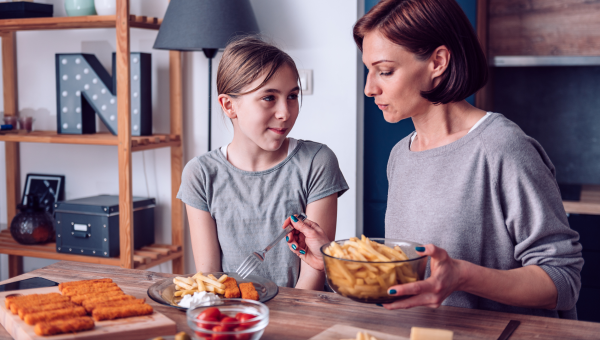Autism and food aversion: how to help your picky eater
Our tips can help you cope with your picky eater and avoid mealtime meltdowns.

Kids are notoriously picky eaters. But for children with autism spectrum disorders (ASD), a finicky appetite can mean something more serious. “[Children with autism] that have food aversions can have inadequate nutrition,” says autism expert and author Chantal Sicile-Kira. “Researchers have found, in particular, an overall low intake of calcium and protein.” Such… Show More
Kids are notoriously picky eaters. But for children with autism spectrum disorders (ASD), a finicky appetite can mean something more serious. “[Children with autism] that have food aversions can have inadequate nutrition,” says autism expert and author Chantal Sicile-Kira. “Researchers have found, in particular, an overall low intake of calcium and protein.” Such nutritional deficiencies can severely hinder physical, mental and social development.
If your child has autism and is showing signs of food aversions, these tips can help make mealtime easier.
Show Less
1. Become an expert on your child.
Just as autism manifests differently in each child, so do food aversions. Some kids may have a problem with the smell or taste of a particular food, while others may only want to eat foods with certain textures or colors. Get to know your child’s specific food issues, and take notes on what foods… Show More
Just as autism manifests differently in each child, so do food aversions. Some kids may have a problem with the smell or taste of a particular food, while others may only want to eat foods with certain textures or colors. Get to know your child’s specific food issues, and take notes on what foods they avoid and request. Learning to navigate your little ones’ likes and dislikes will go a long way in preventing lunchtime breakdowns.
Show Less
2. Stick to a schedule.
Regular meals are important for children with autism. “If you let a child eat all the time, they won’t be hungry at mealtime,” says Sicile-Kira. What’s more, a haphazard eating schedule can lead to uneasiness and make food aversions even worse, further delaying your child’s willingness to try new… Show More
Regular meals are important for children with autism. “If you let a child eat all the time, they won’t be hungry at mealtime,” says Sicile-Kira. What’s more, a haphazard eating schedule can lead to uneasiness and make food aversions even worse, further delaying your child’s willingness to try new things. Establish a consistent routine with regular activities before and after each meal, and make sure each child has a designated seat at the table.
Show Less
3. Make trying new foods fun.
Trying to get a child with ASD to eat broccoli for the first time at the table could spell trouble. Instead, think outside mealtime. “Playing with food during play time or down time is how you will get a child to taste new foods,” says Sicile-Kira. She suggests fun activities, like playing catch… Show More
Trying to get a child with ASD to eat broccoli for the first time at the table could spell trouble. Instead, think outside mealtime. “Playing with food during play time or down time is how you will get a child to taste new foods,” says Sicile-Kira. She suggests fun activities, like playing catch with cherry tomatoes, painting with red pasta sauce or using different veggies to make faces on a pizza. “If you change the way you play with the food, your child will start looking forward to [meals] even more."
Show Less
4. Test the waters -- slowly.
Start with foods you know your child will tolerate. Give those the most space on the plate, then introduce smaller amounts of new food. Swap in similar substitutes, too: If your child likes crunchy cereals, try a healthier option with a similar texture, like granola. If they get turned off by some… Show More
Start with foods you know your child will tolerate. Give those the most space on the plate, then introduce smaller amounts of new food. Swap in similar substitutes, too: If your child likes crunchy cereals, try a healthier option with a similar texture, like granola. If they get turned off by some textures, try introducing new foods by pureeing them first. Don’t try to sneak in new flavors with a favorite food, as your child may find this upsetting. Instead, let your child take control, and encourage him to mix foods together as he likes.
Show Less
5. Be flexible. And patient.
You’re going to have good days and bad days. You may have to offer you daughter a banana 30 different times before she decides she wants it, or she may turn up her nose up at a food she just ate yesterday. That’s okay. Try your best to not become overwhelmed. Your child will sense your unease and… Show More
You’re going to have good days and bad days. You may have to offer you daughter a banana 30 different times before she decides she wants it, or she may turn up her nose up at a food she just ate yesterday. That’s okay. Try your best to not become overwhelmed. Your child will sense your unease and begin to associate dinner with distress, making a meltdown more likely.
Show Less
6. Celebrate small victories.
Enjoying the smooth texture of a grape or taking a bite of a carrot can be a huge step forward, even if your child decides she doesn’t like it. Use calm praise to encourage her to try again next time. Never try to use punishment or reward systems, warns Sicile-Kira. “Punishing is never effective,”… Show More
Enjoying the smooth texture of a grape or taking a bite of a carrot can be a huge step forward, even if your child decides she doesn’t like it. Use calm praise to encourage her to try again next time. Never try to use punishment or reward systems, warns Sicile-Kira. “Punishing is never effective,” she says. “Rewarding may be effective at the moment ... but it’s not effective for developing good habits in the long run.” Instead, Sicile-Kira says, make trying new foods fun, and you’ll help your child form good eating habits over time.
Show LessMore On


video

article


video


video


video
